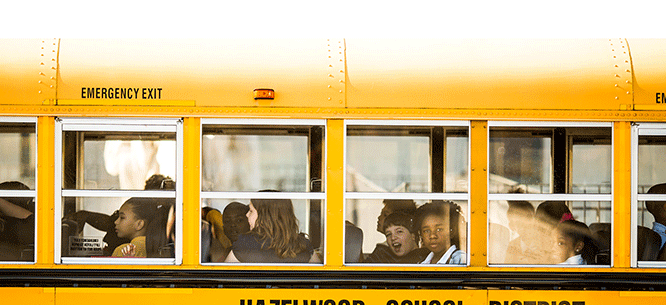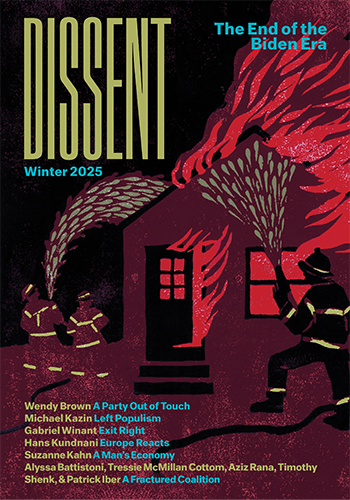Closing Doors: Race and Opportunity in St. Louis Schools
Closing Doors: Race and Opportunity in St. Louis Schools
Decisions about where to build or close a school are not just responses to demographic change. They are drivers of it.

In early December, the St. Louis Superintendent of Schools announced plans to permanently close six elementary schools, one middle school, and four high schools (one of which is becoming a middle school). Of the eleven schools on the chopping block, seven are north of the notorious “Delmar Divide”—a hard boundary between white and black St. Louis that has held fast since the first half of the twentieth century. African Americans make up just under half (46.4 percent) of the city’s population (based on the latest five-year American Community Survey), but they account for 91.4 percent of the population north of Delmar. Among the proposed closures is Sumner High School, which at its founding in 1875 was the first high school for African Americans west of the Mississippi.
An outpouring of community disappointment and anger forced the St. Louis Board of Education to grant a stay of execution, bumping the vote on school closings to its next meeting on January 12. But the threat to public education in St. Louis—and especially north St. Louis—remains. Framed as a necessary response to the city’s longstanding loss of population, the school closings are just another marker of historical and systemic disinvestment in black St. Louis.
The announcement in early December follows over forty school closings in the city of St. Louis (three-quarters of these north of Delmar) since 1983, in the face of a stark decline in enrollment. In 1967, St. Louis Public Schools (SLPS) enrolled 115,543 students; today it is under 20,000. Enrollment in the patchwork of twenty-three school districts in suburban St. Louis County, by contrast, is nearly 140,000, with more students in the Rockwood district alone than the entire city.
The principal culprit here is white flight. Since 1950, the city’s population has shrunk by nearly two-thirds (from a 1950 population of 856,796 to a 2019 estimate of just 300,576), shedding almost 80 percent of its white population. White flight was, in some respects, a precursor to the politics of “school choice”: families were drawn not only to the federally subsidized and racially restrictive suburban neighborhoods but to racially gerrymandered school districts sprawling to the west of the city.
White families that remained in St. Louis abandoned SLPS. Between 1940 and 1970, the share of black children in SLPS was 50 percent higher than their share of the population, as the remaining white students fled to private and parochial schools. Today, while the school-age African-American population closely tracks SLPS enrollment, only 38 percent of school-age white children in St. Louis attend public schools. The pattern is a familiar one: the history and legacy of racial segregation, in St. Louis and elsewhere, magnified in the public schools.
By any measure, SLPS is struggling. Students in the district score over two grade levels below the U.S. average on standardized accountability tests in math and English language arts administered to students in grades 3–8, and almost a full grade level below districts with similar socioeconomic profiles. The racial opportunity gap is even wider: the district’s white students score marginally lower than national averages (-.11 grade levels), while African-American students score 2.46 grade levels lower. These dismal metrics led the district to lose accreditation from the state board of education in 2007, and it didn’t regain fully accredited status until 2017.
The yawning opportunity gaps, the enrollment collapse, the latest round of school closings—for SLPS, these failings are a torrent beyond its control. “We operate downstream from political forces that have divested themselves of our neighborhoods and our children,” states the board document summarizing the latest closings. This is essentially the same argument that SLPS made in 1973 at the outset of the nation’s longest and most expensive school desegregation battle. In response to Liddell v Board of Education, the court case that spurred desegregation in the city, SLPS attributed the deepening segregation of the city’s public schools to forces “unforeseeable and/or beyond the control of the Board.”
There was—and remains—some truth to the argument that SLPS is not directly responsible for the racial divisions in the St. Louis school system, or for a half-century of residential and commercial flight from the city. Much of that damage was done by other jurisdictions. In the wake of federal “slum clearance,” urban renewal, and public housing policies, as Gary Orfield concluded in his expert opinion for the Liddell case, “a river of public money washed through parts of the City and, once again, left more children attending segregated schools in segregated neighborhoods.” The municipalities and school districts west of the city gladly poached St. Louis’s middle-class families—and their property taxes. Property tax abatements passed by the city have also robbed SLPS of revenue. And when the Liddell litigation finally forced a settlement in 1983, SLPS got the short end of the stick.
Desegregation was premised on an inter-district busing and transfer program that would integrate suburban schools, the development of magnet schools in St. Louis, and a commitment to capital improvements for older school buildings. But the actual investments were meager, and the burden of integration fell largely on black students riding buses out to suburban districts. White parents left SLPS in such droves that the Catholic and Lutheran parochial schools had to pull the plug on new transfers.
In turn, not long after the desegregation plan was launched, both civil rights law and local policies began to retreat from integration. The state of Missouri, always a reluctant partner, forced a new settlement in 1999 that phased out both the inter-district plan and the state’s financial commitment. SLPS and a shrinking roster of participating suburban districts sustained the program—without state support after 2008—until its termination in 2019. At that point, SLPS was as staunchly segregated as it had been a generation earlier.
Segregation shapes not just the distribution of students but the district’s fiscal capacity. In St. Louis and its suburbs, the median assessed property value in majority-white school districts is nearly double that of majority-black districts. The latter (including SLPS) can only narrow that gap with state aid and by taxing their residents at higher rates. The school tax levy (per $100 of assessed property value) in the suburban Ladue School District (median household income $214,875) is 2.7625; the school tax levy in St. Louis City (median income $43,896) is 4.378.
The net result, as new work from Forward Through Ferguson underscores, is a startling misallocation of resources. Median per-student spending in SLPS and the six majority-black districts in St. Louis County is $13,441; in the nineteen majority-white districts in St. Louis and St. Charles Counties, the median expenditure ($15,516) is over 15 percent higher.
All this considered, SLPS is hardly an innocent “downstream” victim. In the first twenty years after the Brown v. Board of Education decision, district policies—including decisions on new construction, busing, and school catchment boundaries—all deepened local patterns of school segregation. Neither the district nor the state made the investments that would have allowed the city’s “magnet” schools to draw students into the district at anywhere near the same rate that the desegregation plan (and continued white flight) were emptying schools out. And as soon as state financial support for desegregation phased out, the district turned to charter schools to repair the damage, with charter boosters telling a familiar story: privatization of school operations would control costs, encourage innovation, and unleash the competitive discipline of parental “choice.”
The city used a fiscal pinch in 2002 as a pretext for overhauling school governance. Over the next few years, SLPS closed twenty-one schools, slashed spending, and privatized or outsourced building maintenance and school lunches. The district’s loss of accreditation in 2007 was a result of this rampage and a boost to the charters. School buildings were offered rent free to charter operators. Today, charter schools siphon off nearly 40 percent of the city’s public school students.
The promised benefits of the charter school revolution have, as elsewhere, proven elusive. The principle innovation offered by local charters is a “no excuses” approach to student conduct, which has widened racial inequities. Charters also offered no demonstrable savings or fiscal relief (under Missouri law, as in most states, state aid and local revenue follow the student; charter enrollment poaches public schools of students and revenue). And the broader democratic implications—in terms of transparency, equity, and opportunity—of ceding public education in St. Louis to private interests have gone largely unexamined.
While it is now conventional to center economic development policy around “eds and meds” on the assumption that local hospitals and universities provide stable foundations of mixed-skill employment and spillover investment, public schools are rarely accorded this status. In St. Louis, school buildings are viewed less as neighborhood anchors than as real-estate assets. SLPS has been reduced to touting the conversion (and gentrification) of school buildings into luxury condominiums as the successes of its “Building Revitalization Collaborative.”
School closings effectively consecrate neighborhood decline. In the Liddell case, African-American families in north St. Louis argued that they were “trying to stabilize their neighborhoods,” and that “neighborhood schools are key factors in this stabilization.” The presence of a neighborhood school may not save a neighborhood, but closing that school will surely condemn it.
Decisions about school catchment zones and district boundaries, or about where to build a school or where to close a school, are not just responses to demographic change. They are drivers of it. In St. Louis and elsewhere, district boundaries are either remnants of segregation or naked attempts to reinscribe it. And, as historian Ansley T. Erickson and others have shown, school districts have a penchant for chasing “nice white parents” across the metropolis, slavishly following—and even sometimes leapfrogging—their flight from central cities and their public goods.
In this respect, the city of St. Louis and SLPS have only a few levers at their control. They cannot prevent the construction of well-resourced new schools in the cornfields of exurban St. Charles County. But they can—and should—engage in a fiercer defense of the public schools that anchor their own neighborhoods, and shape the opportunities of those who grow up in them.
Colin Gordon is a professor of history at the University of Iowa. He is the author of, most recently, Growing Apart: A Political History of American Inequality and Citizen Brown: Race, Democracy, and Inequality in the St. Louis Suburbs.




